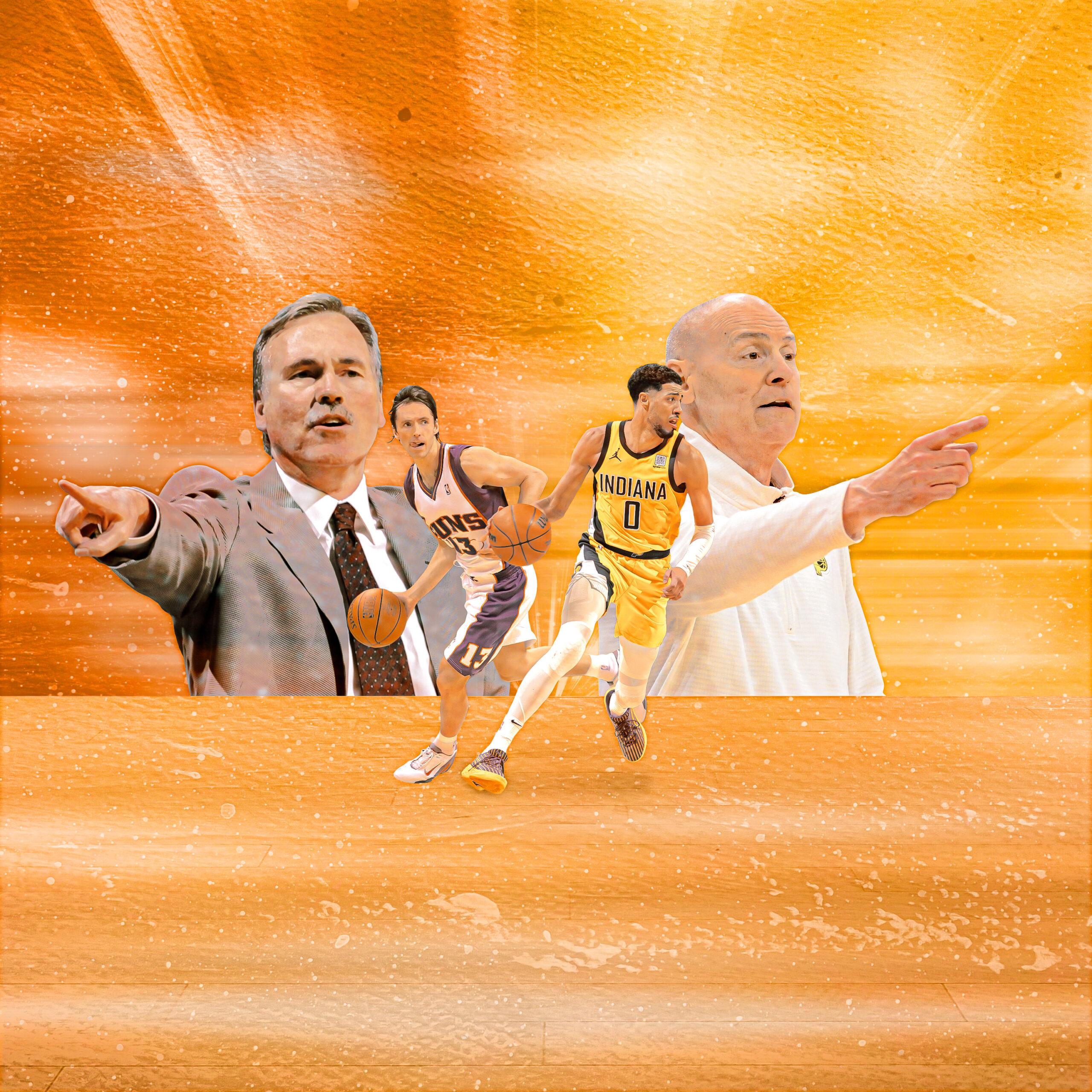
Twenty years ago, Rick Carlisle saw a vision of basketball’s future. It was fast and furious, disorienting, and a little daunting. Players sprinted from end to end, their bodies and the ball in constant motion. Three-pointers rained down from everywhere.
“This is a different type of science project,” Carlisle, a little awestruck, said then. “This is really very unique.”
Carlisle, 45 years old at the time, was in his fourth season as an NBA head coach—his second with the Indiana Pacers, a squad built on old-school brawn and physical aggression. The vision he’d just witnessed was not a fever dream, though it did leave bystanders soaked in sweat and anxiety. The “science project,” dubbed “Seven Seconds or Less,” had been devised by the wily new head coach of the Phoenix Suns and brought to life by a playmaking wizard with floppy hair and a creative flair.
“I’m amazed at the implementation of this [system] and how well they do it,” Carlisle said in January 2005. “To me, it’s one of the great stories of the league this year.”
Back then, Mike D’Antoni’s frenetic, fast-paced, 3-point-happy offense was considered a curiosity, an experiment—entertaining, sure, but not sustainable or suited for winning championships in a league ruled by behemoths and bangers who did their scoring close to the basket. The NBA then was still a league of laborious post play and mind-numbing isolations, with one player pounding the ball into oblivion and everyone else watching. The Suns were happy revolutionaries, defying decades of basketball convention, racing to 62 wins in the face of scorching skepticism. Purists dismissed them as serious contenders, even as D’Antoni and his pass-happy point guard, Steve Nash, set the league ablaze.
It's now 2025, and scoffing and skepticism have (mercifully) long since faded. The science experiment is now the norm: Just about every NBA team pushes the pace, spreads the court, and shoots a lot of 3s. And the team that most resembles the old Suns—with a frenetic offense and a pass-happy point guard—is now in the NBA Finals, two wins away from a title.
And now it is D’Antoni, happily retired and living in Austin, Texas, who is watching with awe and appreciation as Carlisle—who returned to the Pacers in 2021—sets opponents ablaze with a modern, supercharged version of his “Seven Seconds or Less” team.
“I enjoy watching Indiana,” D’Antoni told The Ringer last week, a day after the Pacers snatched Game 1 of the Finals from the heavily favored Oklahoma City Thunder. The series is now tied at 2-2, with Game 5 set for Monday night in Oklahoma. “They've put together a team that plays similar to the 2004 Phoenix Suns—but I think at a higher level.”
Higher, because the Pacers play even faster and shoot (and make) more 3s than those Suns ever did. But then, the entire league plays faster and shoots more long-distance shots today than anyone dared in the mid-2000s, before D’Antoni and Nash sparked this revolution.
In 2004-05, the first year of the D’Antoni-Nash partnership, the Suns led the NBA in pace (97.4 possessions per game), offensive rating (112.7), 3-point attempts per game (24.7) and 3-point makes per game (9.7). In 2024-25, those marks would place the Suns 27th in pace, 21st in offensive rating, and last in both 3-point attempts and makes.
Indeed, the league has transformed so dramatically that these Pacers, despite their obvious similarities to the old Suns, are not even the league leaders in these categories. They were seventh this season in pace (100.8), ninth in offensive rating (115.4), 21st in 3-pointers taken (35.8), and 16th in 3s made (13.2). But functionally and aesthetically, no modern NBA team more embodies the spirit of the D’Antoni Suns.
The Pacers, led by point guard Tyrese Haliburton, look to sprint at every turn—not just off of steals, blocks, and defensive rebounds, but also off of made field goals and free throws. Haliburton, like Nash, loves to throw the hit-ahead pass in transition, sparking early shot opportunities before the defense can get set. “Getting the ball in quick, getting it up and striking fast,” D’Antoni said.
The “Seven Seconds or Less” mantra—made famous by Jack McCallum’s book of the same name—referred to how quickly the Suns wanted to shoot into the 24-second shot clock. Players were expected to make quick decisions with the ball, never holding it for too long, and almost never isolating.
Indiana’s frantic pace isn’t limited to transition play. In the half court, the Pacers are in almost constant motion, moving and pinging the ball around, a style that leaves defenders off-kilter—and, eventually, exhausted. When Haliburton takes a breather, T.J. McConnell infuses his own manic energy into the offense, even executing the occasional “Nash dribble,” by driving baseline and popping out the other side to re-attack the defense.
At Gainbridge Fieldhouse, Indiana’s home court, all that zipping and sprinting is soundtracked by the literal hum of Indy 500 cars, which plays frequently over the PA system.
“They’re a very fast team,” Thunder star Shai Gilgeous-Alexander said before the Finals. “Above all, they understand how they’re playing, and they’re very stubborn in their approach. They kind of like grind you with the way they play. They wear you down.”
Indiana ranked second in passes per game (330.5) this season, just behind the Golden State Warriors, another team with bits of Suns DNA in its system. In the postseason, the Pacers are first in passes per game (318.6), assists per game (27.3), and points off assists per game (70.9). Through four games of the Finals, they’re averaging 335.5 passes—over 100 more per game than the Thunder (217.8).
“If we move [the ball], that’s where the defensive mistakes happen,” said Lloyd Pierce, the Pacers’ lead assistant coach. “So if we get five [passes] on a possession, somebody’s late on the rotation, somebody’s late on a closeout, somebody is supposed to tag, and then we get a paint-to-great [shot].”
It’s probably more than a coincidence that the Pacers’ magical, wholly unexpected postseason run has been fueled by so many uncanny comebacks and late-game heroics. By the time they get to the fourth quarter, opponents are often gassed.
It surely felt that way in Game 1 of the Finals, as the Pacers methodically erased a 13-point deficit in the final 10 minutes, then won the game on a deep jumper by Haliburton with 0.3 seconds left. By Game 2, the Thunder seemingly had adjusted to the Pacers’ style, taking a 123-107 win.
“Indiana is kind of an acquired taste,” Thunder coach Mark Daigneault said afterward. “We haven’t played them a ton. They’re not in the West, obviously. They play a very distinct style on both ends.”
And there’s little question that the Pacers of today are, at minimum, spiritual cousins of the Suns of yesterday. But it’s a little more than that. Carlisle and D’Antoni have spoken many times in recent years, though neither one wanted to divulge much about those conversations.
“I’ve always kept in touch with Rick,” D’Antoni said, “but I’ve never really sat down and formally talked to him about basketball. … Rick is just one of those smart coaches that adapted. He’s just done a remarkable job in the last two years. So I’m not going to take even an ounce of credit. He’s done this, and he’s done an unbelievable job.”
Carlisle, in turn, called D’Antoni “a visionary” who was “ahead of his time” and whose “impact on the game is indelible.”
“He’s been so great to coaches over the years,” Carlisle told The Ringer. “He’s been generous with his time and his experiences, and he’s helped a lot of us. … He saw a game where the skill level at every position would increase to where it is now. And it will continue to evolve beyond this at all five positions.”
Indeed, the 2025 Pacers have advantages that the 2005 Suns could only have dreamed about. D’Antoni’s philosophical ideal was a lineup in which all five players could dribble, pass, and shoot the 3. His Suns never quite got there, because most bigs of that era lacked the skill sets. Phoenix deployed Amar’e Stoudemire, a pick-and-roll (and eventually a pick-and-pop) forward as the small-ball center, then surrounded him with shooters, from Nash to Shawn Marion to Quentin Richardson, Joe Johnson, and Raja Bell. But Stoudemire was never a long-distance shooter, nor much of a rim protector.
The Pacers have Myles Turner, who can block shots on one end and spread the defense with his 3-point shooting on the other. Indiana can truly go five-out, with skill and shooting at every position, from Andrew Nembhard to Aaron Nesmith to Pascal Siakam, who combines Marion’s nimble defense with Stoudemire’s length and power dunking.
As Carlisle said in a recent press conference, “We’re getting to a point now where everybody on the floor, not a hundred percent of the [centers], but all the guys, 1 through 4, can make 3s, drive it, make plays. And we’re getting to a point now where more of the 5 men can do that than not. It’s made the game a lot more difficult to defend.”
But everything begins with Haliburton, a joyful, selfless passer who draws easy comparisons to Nash. Carlisle said the impetus to move to a more up-tempo system began when the Pacers acquired their star point guard from Sacramento in February 2022.
“It’s clear that he was a high-tempo player,” Carlisle said. “That was not only a strength of his, but it was also a natural part of his makeup as a player, and it was clear that we needed to build a team of speed and tough guys around him.”
Amazingly, Nash and Haliburton had never spoken at length until just before these Finals, after being connected by Pierce, a longtime friend and former college teammate of Nash’s. The two mostly spoke about the “mental component” of playing deep into the playoffs, and how to “balance the emotional side” of being the focal point of the team, Pierce said.
But they did not apparently compare notes on their offensive systems, and Pierce said the Pacers coaching staff doesn’t generally reference the Suns in film sessions. Much of the Pacers’ playbook is indeed distinct from the Suns’. But both share the same hallmarks: pace, ball movement, shooters sprinting to the corners in transition, and a fair amount of improvisation. “I think the biggest component is [how] the space, the pace, allows you to make reads. We have a very similar point guard to Nash that gets off the ball quick, gets off the ball often, and he can make great reads, and that’s what we’re emphasizing,” Pierce said.
Like Nash was in his prime, Haliburton today is sometimes criticized for not shooting or scoring enough—for being too selfless. Nash, of course, loves what he sees, in both the Pacers offense and Haliburton in particular.
“I love that he throws the ball ahead,” Nash said on a recent episode of his Mind the Game podcast with LeBron James. “It really feels to me like they’ve empowered all these guys. It’s almost like maybe the most equal-opportunity offense. … One of the things the Pacers do to teams is they stretch your bandwidth. You get mentally fatigued with the chaos.”
For months now, the fourth-seeded Pacers have defied and exceeded expectations, bouncing the Milwaukee Bucks, the top-seeded Cleveland Cavaliers, and the gritty New York Knicks on their way to the Finals stage. They weren’t supposed to get this far because they were presumably too young, too inexperienced, and too soft on defense.
But the most striking part? No one ever dismissed the Pacers for being too quick, too 3-point happy, too offense-minded—all criticisms leveled at the “Seven Seconds or Less” Suns. No one is debating anymore whether you can win a title this way. (The Warriors squashed that claim 10 years ago.) And D’Antoni is no longer seeking vindication. He can see it every day of the season—a game that has become quicker, more energized, more skilled, fueled by players who are increasingly more versatile.
“The coaches that are in it today, they’ve been moving that way, and they’re going to keep moving that way, and it’s not going to go back to the other way,” D’Antoni said. “I think the NBA is in a great place.”

